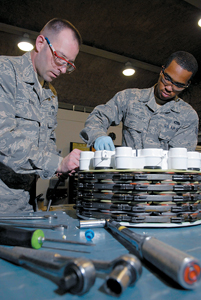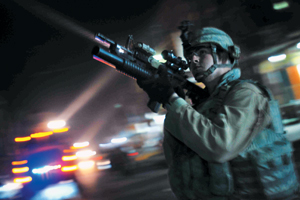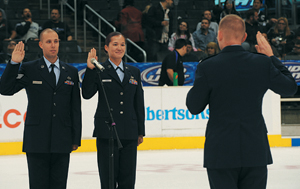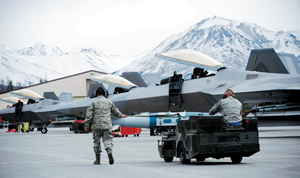Last June, the Air Force halted a force drawdown that had begun in 2005 and was more than two-thirds complete. Rather than cut a final 10,000 from USAF’s end strength, personnel managers were told to reverse course and start expanding the active force to a target of 330,000 officers and enlisted airmen.
The reason? USAF had become too small to support wartime operations and emerging missions. Simply put, USAF members were being asked to do too much.
Personnel managers saw evidence of this in poor enlisted retention rates. Fiscal 2008 retention goals were repeatedly missed, and enlisted retention finished the year at 88 percent of the goal.
 |
TSgt. Wayne Birkand (l) and SrA. Joseph Northcutt assemble a KC-135 brake at an air base in Southwest Asia. |
The service quickly adjusted: This year, enlisted retention has improved, largely due to an expansion of re-enlistment bonuses. Today, officials express cautious confidence that force retention is back on the right path.
“We were in a downsizing mode in Fiscal 2008,” said Col. Kenneth Sersun, deputy chief of USAF’s force management division in the Pentagon. The Air Force was “hurting significantly on the enlisted side” in retaining the right numbers of airmen in all three enlistment zones.
The Air Force received $46 million for re-enlistment bonuses in 2008 (far less than it had requested), but defense officials took notice as the service missed its monthly targets.
The worry about whether USAF would be able to keep the proper number of airmen in uniform deepened after Defense Secretary Robert M. Gates announced that the Air Force’s self-imposed drawdown, to free up money to recapitalize its aircraft fleet, would end at 330,000 personnel.
“That completely shifted our paradigm,” Sersun said.
The retention challenge was about to get much more difficult. Far from just halting the drawdown, USAF needs additional personnel for securing and managing nuclear weapons; more airmen for unmanned aerial system operations; expanded special operations forces; and airmen for burgeoning intelligence-surveillance-reconnaissance missions.
The Air Force increased its Selective Re-enlistment Bonus program significantly, to “three times what it was in ’08,” Sersun said. This year, USAF has gone from $46 million to $137 million in bonus money and from 37 eligible Air Force specialty codes for bonuses up to 88.
Lt. Gen. Richard Y. Newton III, deputy chief of staff for manpower and personnel, testified in March that the restored SRB program had left the Air Force “well positioned … to meet FY09 retention goals and ensure we retain the right airmen, with the right skills, at the right time [for] our expeditionary requirements.”
Stressed Specialties
Through February, enlisted retention was at 93 percent of the year-to-date goals. Compared to the recruitment-driven Army, Sersun said the Air Force has a “much greater need to retain personnel and, consequently, we’re doing it this year.”
Air Force officials played down the effects of a collapsing private-sector job market on their retention successes. This may reflect concern that market forces could be used to justify another slash in bonus programs, limiting the ability to react to manpower challenges—especially when the economy recovers.
 |
Jarrett Cox keeps guard during a patrol through the Sadiah district of Baghdad. |
“There has been a lot of speculation, particularly from the Army, that the economy is what drives retention,” Sersun elaborated. “In the Air Force, that’s not a significant aspect. We are a completely different force from the Army, … a retention-based force, more technical in nature, with longer training times.”
In March, the Navy made the largest cut to the re-enlistment bonus menu in recent memory. Sersun said no such announcement would be coming from the Air Force, which faces a different set of challenges. Seven percent of Air Force officers and almost 13 percent of enlisted personnel serve in “stressed” career fields—those with very high deployment rates, manning shortages, or some combination of the two. Some 38,000 airmen are affected.
Officially stressed enlisted career fields, affecting 33,000 personnel, include combat control, tactical air control party, pararescue, pavement/construction equipment, structural, operations management, explosive ordnance disposal, security forces, and contracting.
Stressed officer specialties, involving 4,600 personnel, are control and recovery, special operations navigator, airfield operations, security forces, civil engineer, contracting, and public affairs.
It is inaccurate to portray the service overall as “overworked, tired, and worn out,” Sersun said. “Yes, we are working hard, but … they’re all in. They are ready to go.”
Contrary to popular perception, the pace of deployments thus far has not exacerbated the retention problems.
Surveys of Air Force personnel just don’t bear out that concern. “We don’t have any data that support the [notion] that deployments are hurting retention,” Sersun said. “As a matter of fact, we have some data to the contrary, that deployments are good for retention.”
Selective re-enlistment bonuses for enlistees and critical skills retention bonuses for officers remain the best tools to keep ranks full of quality airmen with the right skill mix, Sersun said. With bonus programs properly funded, “we’re very confident we’re going to meet our retention goals this year.”
Skill-specific challenges remain, however, with some AFSCs seeing significant shortfalls—and retention numbers overall are below what the service feels it needs to quickly shape the force.
Officer retention was strong last year, achieving 112 percent of the overall goal. It remains healthy this year and might hit all-time highs in the 20,000-strong rated officer community of pilots, combat systems officers, and air battle managers.
“We’re enjoying some of the best retention in the rated officer world that we’ve really ever seen,” said Lt. Col. David T. DuHadway, chief of rated force policy on the Air Staff. That’s critical because the rated community will absorb most of the force growth required for new or expanding missions.
Besides the robust UAS requirement of “50 full-motion-video combat patrols by the end of 2011,” DuHadway said, “Air Force Special Operations Command is very actively buying aircraft and fielding them fairly rapidly.”
These include the new Liberty Project Aircraft, the MC-12 light ISR aircraft, with a total demand for pilots that could top 300. The demand for rated officers for these new missions will be met primarily through retraining, not growth in officer numbers, DuHadway said.
“We have to find ways of providing the aircrews for all these platforms on top of what we’re already doing,” he said. “Having good retention, which we have right now, is the key. It’s providing us with a foundation and the ability to sufficiently man all these mission areas.”
The Aviator Continuation Pay bonus program for rated officers showed a take rate of 68 percent last year, which is high.
This year, the Air Force opened ACP even to retirement-eligible officers. Also, some who did not take ACP in their first year of eligibility are being offered it again.
“In the past, we opened it up only the year that their commitment was up, and if they choose to take it, great; if they didn’t, they weren’t eligible anymore,” DuHadway explained. “We have a lot of requirements that have grown inside of our programming cycle.”
The Air Force has found that many pilots who decline the ACP bonus, which comes with a lengthy additional service obligation, are sticking around. The retention rate for these pilots is as high as 90 percent for some year groups.
Why do they stay in such numbers
 |
SSgt. Robert Coddington and TSgt. Surita Rorie re-enlist at a hockey game in Los Angeles. |
“Right now, airline hiring is virtually nonexistent,” DuHadway said. There isn’t always “a direct correlation between the health of the airline industry and the strength of our aircrew retention,” he added, but “given that we have significant requirements growth, that is helping us significantly.”
Short-term Turbulence
The ACP for pilots is offered after the initial pilot training commitment expires after 10 years of service. ACP bonuses offer pilots $25,000 a year for up to five years of additional service. Battle managers and retirement-eligible officers in all three rated categories are being offered $15,000 a year. The Air Force also has a voluntary recall program for retirees and reserve component aircrew officers—by mid-March, about 350 had applied this year.
“We think these two programs will help us get through what we see as some short-term turbulence trying to meet very high priority requirements,” said DuHadway.
“Retaining the right skills is a huge concern,” Sersun said, “particularly as we’re growing some missions and adding [personnel] authorizations to different areas.”
In fact, aggregate retention numbers are not enormously useful. Meeting skill-specific goals is far more consequential.
“If we have 600 cooks and need only 300 cooks, that doesn’t help the explosive ordnance troops in the field,” Sersun explained. “The SRB program is helping us to [retain] effectively.”
The Air Force will face a critical retention environment in 2010. Officials expect difficulty keeping some large career groups filled—particularly maintainers, vehicle managers, civil engineers, communications and computer system operators, and special operators.
Some AFSCs represent new areas for shortages.
The problem is tied to how rapidly the Air Force tried to reduce force strength beginning in 2005: To reach lower personnel targets, the service accessed only to 60 percent of requirements, signing 19,000 recruits instead of 32,000. So starting this year, force managers have to keep retention for the 2005 year group unusually high to avoid long-term skill and experience shortages.
Operational demands will stress the service in new ways, as some forces shift from Iraq to Afghanistan and the Air Force prepares for the emerging mission areas.
“This is one of the reasons why we need to continue to have a robust SRB program,” Sersun said. “Those career fields that we offer the highest SRBs to are also the ones” that are growing.
Over the past year, the Air Force has added 2,500 personnel to what it calls its “nuclear enterprise” mission, the No. 1 priority for Gen. Norton A. Schwartz, Air Force Chief of Staff.
 |
|
Those personnel include security forces, command post controllers, munitions experts, and maintenance specialists for ICBMs and nuclear-capable aircraft. It takes bonuses to keep these airmen, even in a weak economy.
“They have lots of opportunities on the outside,” Sersun said. Security forces airmen, for example, often work in theater side by side with Blackwater contractors “making three or four times what the enlisted troop is making. … You can imagine there’s a lot of pull there.”
A bonus policy change this year is helping retain the most critical skills. The $60,000 cap on SRB awards was raised to $90,000, the maximum allowed by law. As a result, bonus awards for some Zone C enlisted members (those with 10 through 14 years of service) in critical skills such as pararescue have jumped by $30,000 for long-term contracts.
While retention is very strong among officers, a few pockets of concern remain. They involve some health professions, control and recovery officers supporting special forces, and contracting officers.
USAF this year is using $65 million in medical bonuses to keep additional surgeons and biomedical science officers on its rolls. It also has deployed a new control and recovery bonus—and hopes to win approval for a contracting officer bonus.
Tom Philpott, the editor of “Military Update,” lives in the Washington, D.C., area. His most recent article for Air Force Magazine, “Total Force Tricare,” appeared in the April 2004 issue.